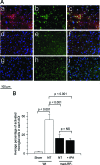The low-density lipoprotein receptor-related protein 1 mediates tissue-type plasminogen activator-induced microglial activation in the ischemic brain
- PMID: 19147818
- PMCID: PMC2630566
- DOI: 10.2353/ajpath.2009.080661
The low-density lipoprotein receptor-related protein 1 mediates tissue-type plasminogen activator-induced microglial activation in the ischemic brain
Abstract
Microglia are the immune cells of the central nervous system (CNS) that become activated in response to pathological situations such as cerebral ischemia. Tissue-type plasminogen activator (tPA) is a serine proteinase that is found in the intravascular space and the CNS. The low-density lipoprotein receptor-related protein 1 (LRP1) is a member of the low-density lipoprotein receptor gene family found in neurons, astrocytes, and microglia. The present study investigated whether the interaction between tPA and microglial LRP1 plays a role in cerebral ischemia-induced microglial activation. We found that middle cerebral artery occlusion (MCAO) induces microglial activation in both wild-type and plasminogen-deficient (Plg(-/-)) mice. In contrast, MCAO-induced microglial activation is significantly decreased in tPA-deficient (tPA(-/-)) mice and in mice that lack LRP1 in microglial cells (macLRP(-)). We observed a significant increase in microglial activation when tPA(-/-) mice received treatment with murine tPA after MCAO. In contrast, treatment of macLRP(-) mice with tPA did not have an effect on the extent of microglial activation. Finally, both the volume of the ischemic lesion as well as inducible nitric oxide synthase production were significantly decreased in macLRP(-) mice and macLRP(-) microglia. In summary, our results indicate that the interaction between tPA and LRP1 induces microglial activation with the generation of an inflammatory response in the ischemic brain, suggesting a cytokine-like role for tPA in the CNS.
Figures






References
-
- del Rio-Hortega P. Microglia. Penfield W, editor. New York: Hoeber,; Cytology and Cellular Pathology of the Nervous System. 1932:pp 482–534.
-
- Hanisch UK, Kettenmann H. Microglia: active sensor and versatile effector cells in the normal and pathologic brain. Nat Neurosci. 2007;10:1387–1394. - PubMed
-
- Ladeby R, Wirenfeldt M, Garcia-Ovejero D, Fenger C, Dissing-Olesen L, Dalmau I, Finsen B. Microglial cell population dynamics in the injured adult central nervous system. Brain Res Rev. 2005;48:196–206. - PubMed
-
- Parathath SR, Parathath S, Tsirka SE. Nitric oxide mediates neurodegeneration and breakdown of the blood-brain barrier in tPA-dependent excitotoxic injury in mice. J Cell Sci. 2006;119:339–349. - PubMed
Publication types
MeSH terms
Substances
Grants and funding
LinkOut - more resources
Full Text Sources
Molecular Biology Databases
Research Materials
Miscellaneous

